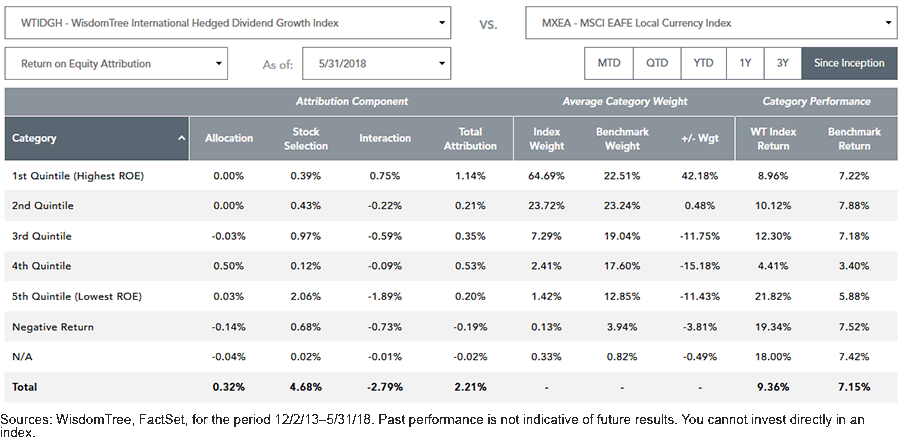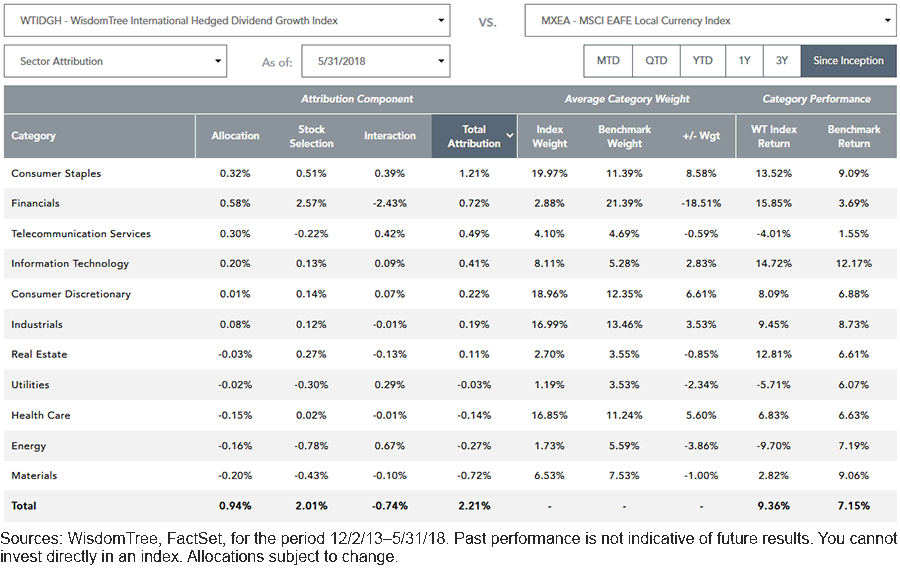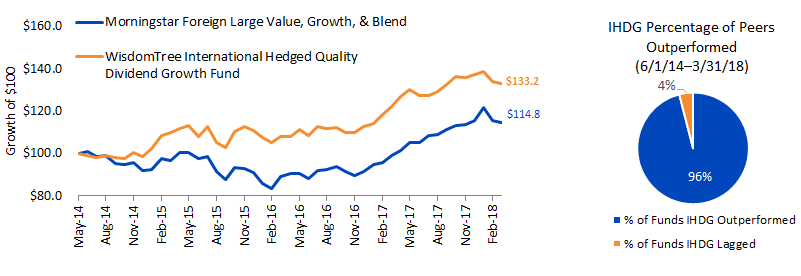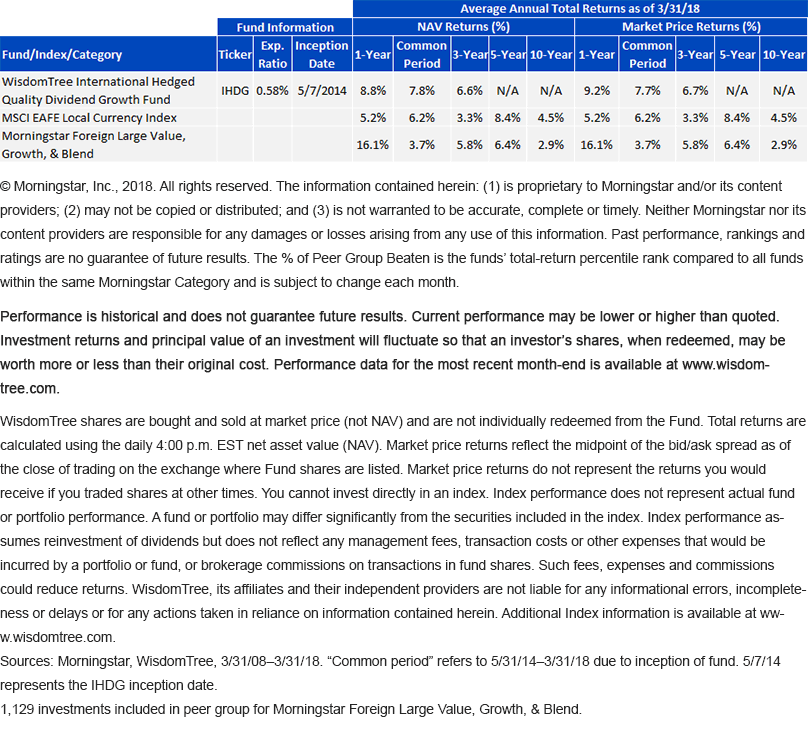What’s Driving the Quality Dividend Growth Performance?


In December 2013, WisdomTree added a novel approach to its stable of international dividend-focused Indexes with the launch of the WisdomTree International Hedged Quality Dividend Growth Index. This Index utilitizes an annual screen on fundamental metrics, including dividend payout ratios, return on equity (ROE), return on assets (ROA) and long-term estimated earnings growth in selecting 300 dividend-paying companies. These metrics were chosen with the aim of constructing a unique rules-based process that targets quality dividend-paying companies with high ability to grow their dividends over time.
As a result of this screening process and weighting by annual cash dividends, some of the characteristics of this Index are materially different from its cap-weighted benchmark. Attribution analysis of some of these key differences is discussed below to provide deeper insight into the Index’s drivers of outperformance since inception.
ROE Quintiles: Nearly Three Times the Weight in the Top ROE Quintile
Breaking down exposures into ROE quintiles helps show the impact of the Index’s quality screen on tilts toward profitable companies and how that has affected performance. This attribution starts by creating ROE categories from the market cap index (five quintiles, separate from two buckets of negative return and a category for when there is no data). After assigning categories, we can then compare the relative weights of each index by category and its performance. The sum of the total attribution in this case shows 221 basis points (bps) annualized outperformance for the quality index versus its market cap benchmark, the MSCI EAFE Local Currency Index.
- The WisdomTree Index has 64.49% allocated to the top ROE quintile versus just 22.51% for the market cap-weighted index, a differential of nearly three times. This higher allocation was the primary driver of outperformance (1.14% of the 2.21%).
- The bulk of the quality index’s 42% over-weight in the top quintile was approximately offset by its 38% under-weight in the bottom three quintiles. In aggregate, this under-weight helped contribute another 108 bps to the Index’s outperformance. This supports the notion of outperformance being critically tied not only to what is included but to avoiding lower quality companies as well.
- When reviewing the returns of the categories in the market cap benchmark in the far-right column, one segment that stands out relative to others is the outperformance of the negative return category. This category’s return of 7.52% was the second best-performing category in the benchmark, even outperforming the highest ROE quintile by 30 bps. With the benchmark having less than 4% weight to this segment, idiosyncratic factors may play a part in defying the trend of undeperformance seen from the bottom two quintiles.

Sector and Country Attribution
In addition to differentiated exposures to fundamentals such as ROE, sector and country attributions help drill into another way to analyze exposures and returns. The sector exposure has tended to be more heavily weighted in the Consumer sectors and Health Care, and significantly less in Financials. From a country perspective, the most notable weight differential in either direction has been an under-weight in Japan of 11.65%. Low dividend payment levels, while growing, have minimized the weights assigned to Japanese constituents relative to market cap weighting—10.92% compared with 22.58%. This under-weight in Japan contributed 50 bps to outperformance for the period.
Chronically low ROEs have left many large financial institutions out of the Index since inception. As of May 31,2018, the screening date for the WisdomTree International Index annual rebalance, MSCI EAFE Financials have an ROE of 8.25%, compared with 11.1% for the broader Index.1 Persistently low interest rates, sluggish growth and regulatory guidelines to bolster capital buffers all point toward continued headwinds for the sector on this key measure of profitability.

In reviewing the largest sector contributors, the Consumer Staples sector was the largest contributor to outperformance, adding 121 bps. The under-weight in Financials was the second largest contributor, adding 72 bps; the Financials sector was the second worst-performing in the benchmark.
For those interested in more time periods and methods to attributing this Index’s performance, please check out our new Index Performance Attribution tool.
WisdomTree International Hedged Quality Dividend Growth Fund (IHDG): Beating 96% of Its Peers since Inception
The Fund tracking this Index, IHDG, has recently crossed its four-year live track record in May. As of the most recent quarter-end, IHDG is sitting close to the top of its peer group, beating 96% of its peers since inception. For investors looking for a differentiated approach that is grounded in exposures to the time-tested characteristics of quality and dividend growth, we think IHDG should be squarely on the radar.


All data as of May 31, 2018, and sourced from WisdomTree and FactSet.
1Sources: WisdomTree, FactSet.
Important Risks Related to this Article
There are risks associated with investing, including possible loss of principal. Foreign investing involves special risks, such as risk of loss from currency fluctuation or political or economic uncertainty. To the extent the Fund invests a significant portion of its assets in the securities of companies of a single country or region, it is likely to be impacted by the events or conditions affecting that country or region. Dividends are not guaranteed and a company currently paying dividends may cease paying dividends at any time. Investments in currency involve additional special risks, such as credit risk and interest rate fluctuations. Derivative investments can be volatile and these investments may be less liquid than other securities, and more sensitive to the effect of varied economic conditions. As this Fund can have a high concentration in some issuers, the Fund can be adversely impacted by changes affecting those issuers. The Fund invests in the securities included in, or representative of, its Index regardless of their investment merit and the Fund does not attempt to outperform its Index or take defensive positions in declining markets. Due to the investment strategy of this Fund, it may make higher capital gain distributions than other ETFs. Please read the Fund’s prospectus for specific details regarding the Fund’s risk profile.


